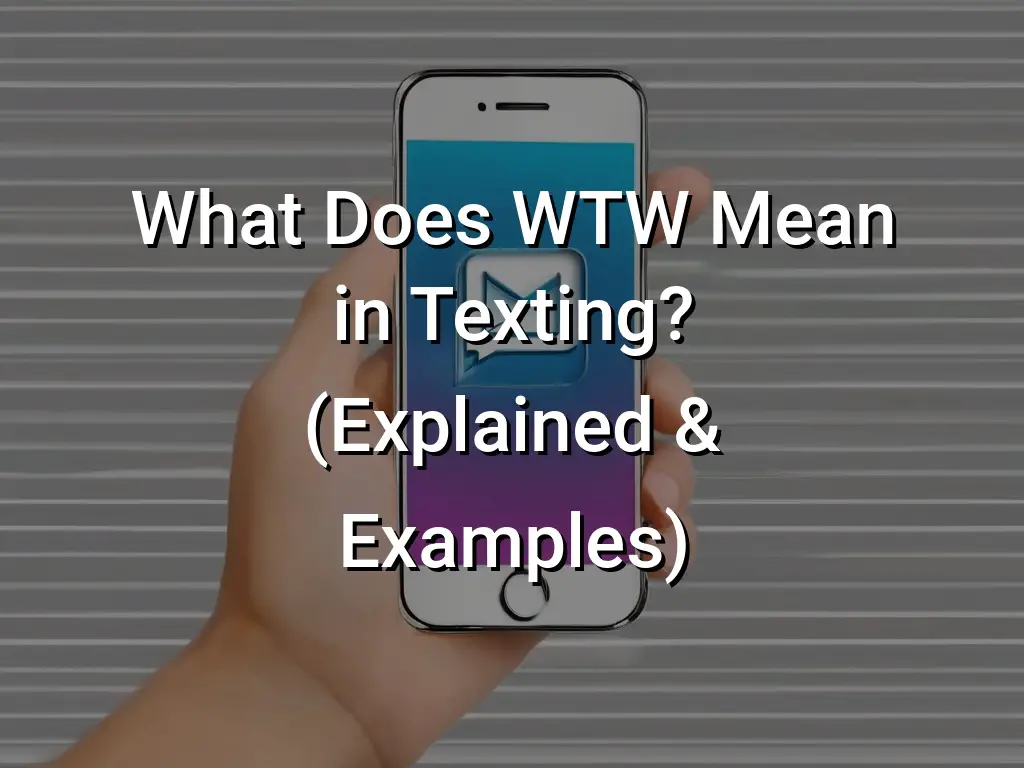What Does WTW Mean in Texting? (Explained & Examples)

Curious about the meaning of the texting abbreviation “WTW”? Wondering what it stands for and how it’s used in conversations? Well, you’ve come to the right place! WTW, which stands for “What’s the Word,” is a popular phrase used in texting and online communication to ask someone what’s going on or what’s up. Let’s dive deeper into the meaning of WTW and how it’s commonly used.
When someone uses WTW in a conversation, they are essentially asking for a brief update or wanting to know what’s currently happening. It’s a casual and friendly way to check in with someone and start a conversation. In this article, we’ll explore the meaning of WTW, provide examples of how it’s used, and give you a better understanding of this texting abbreviation. So, if you’re curious about WTW and want to learn more, keep reading!
What Does WTW Mean in Texting?
The texting abbreviation wtw (or WTW) stands for “What’s the Word.” When someone uses this term in a text message, it is similar to asking “What’s up?” or “What’s going on?” It is a casual way to initiate a conversation or check in with someone.
Usage and Meaning of WTW
WTW, short for “What’s the Word,” is a common texting abbreviation used to inquire about someone’s current status or what they are doing. It is similar in meaning to expressions like “What’s up?” or “What’s going on?” WTW is often used as an informal greeting or conversation starter in text messages or online chats.
The exact interpretation of WTW can vary depending on the context and the relationship between the individuals involved in the conversation. It can be a simple way to check in with someone and show interest in their well-being. For example, if you receive a text message saying “Hey, WTW?” it means that the person is asking about your current activities or any interesting things happening in your life.
In some cases, WTW can be used as a way to initiate more meaningful conversations. If someone asks “WTW?” it may indicate that they are looking for a deeper connection and want to engage in a more substantial discussion about personal experiences or thoughts.
It is worth noting that WTW is similar to other texting abbreviations, such as “WTV” (What’s the Vibes) and “WTLS” (What the Literal Shhhh). These abbreviations are all used to inquire about someone’s current state, thoughts, or feelings, albeit with slight variations in meaning and emphasis. Understanding these subtle differences can help ensure effective and clear communication in digital conversations.
Related Texting Abbreviations
WTV
WTV is a common texting abbreviation that stands for “Whatever.” It is often used to express indifference, nonchalance, or a lack of concern about a particular situation or topic.
WTLS
WTLS is another texting abbreviation that stands for “What the Literal…?” It is often used to express surprise, shock, or disbelief about something that has been said or done.
These texting abbreviations, along with WTW, are just a few examples of the many shorthand terms commonly used in texting or online communication. It is important to familiarize yourself with these abbreviations to better understand the meaning and context of conversations in today’s digital age.
Understanding Texting Abbreviations
In today’s digital age, texting has become a popular and convenient method of communication. With the rise of text messaging, the use of abbreviations and acronyms has also become commonplace. Texting abbreviations are shorthand forms of words or phrases that are used to quickly convey messages in a concise manner.
Texting abbreviations have gained popularity due to their efficiency in saving time and characters while typing messages. They are commonly used in casual conversations, social media posts, and even professional correspondence. Understanding and using these abbreviations can help streamline communication and keep up with the fast-paced nature of modern conversations.
One such texting abbreviation is “wtw” or “WTW,” which stands for “What’s the Word.” It is often used as a greeting or a way to inquire about someone’s current situation. Similar to phrases like “What’s up?” or “What’s going on?”, “wtw” is used to initiate conversation or express curiosity about the latest news or happenings.
It is important to note that texting abbreviations can vary depending on cultural and regional differences, as well as individual preferences. While some abbreviations may be widely recognized and understood, others may be more specific to certain groups or communities. As such, it is always essential to consider the context and audience when using or deciphering texting abbreviations.
Additionally, it can be helpful to familiarize oneself with common texting abbreviations to ensure effective communication. Some other popular texting abbreviations include “lol” (laugh out loud), “brb” (be right back), “omg” (oh my god), and “btw” (by the way), among many others. Understanding these abbreviations can enhance comprehension, facilitate quicker exchanges, and make conversations more efficient.
In conclusion, texting abbreviations are a common feature of modern communication. They offer a convenient and efficient way to convey messages in a concise and timely manner. Familiarizing oneself with popular texting abbreviations, such as “wtw,” can help individuals navigate conversations more effectively and stay in sync with the evolving language of digital communication.
Conclusion
In summary, the texting abbreviation WTW stands for “What’s the Word” and is used to ask “What’s up?” or “What’s going on?” in informal conversations. It is important to be familiar with texting abbreviations like WTW, as they are commonly used in modern communication. By understanding these abbreviations, you can better engage in text conversations with others.
While WTW may have similar meanings to other texting abbreviations like WTV and WTLS, it is important to consider the context of the conversation to fully understand the intended message. By familiarizing yourself with these abbreviations and their meanings, you can effectively communicate and stay connected with others in the digital age.
Remember, staying informed about modern communication trends can help you stay connected and engaged with others in a fast-paced digital world.